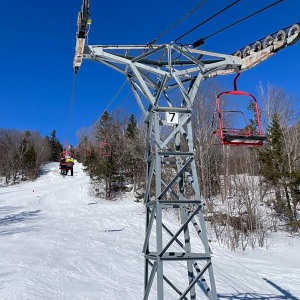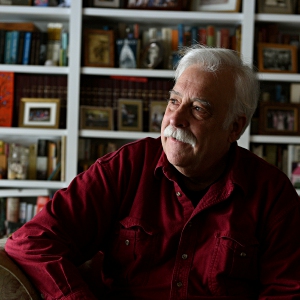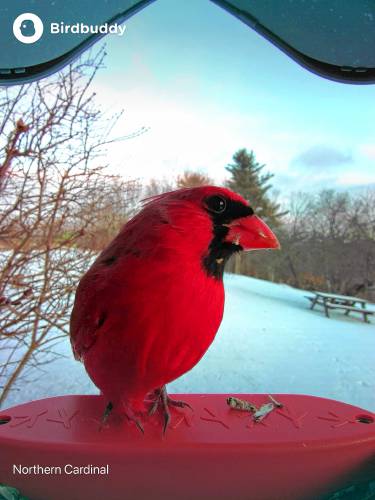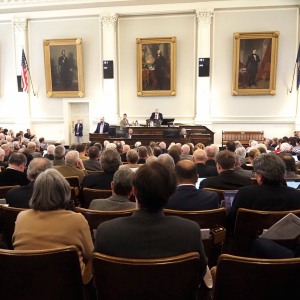Column: Five bird feeders, but only one is ‘smart’
|
Published: 02-21-2025 5:55 PM
Modified: 02-22-2025 7:36 AM |
Recently I received a text announcing that there had been an “unrecognized visitor” to our new bird feeder. Two clicks later a video helped me identify the species: Homo sapiens. This is a bird feeder with a camera and recorded sound, and it had captured my gloved hand and the sound of cascading sunflower seeds as I performed my daily ritual of refilling five bird feeders, no two of them alike, and one of them “smart.”
It was an inspired Christmas gift from our son’s family, people who appreciate how much my wife and I enjoy the color and drama of wild birds on a cold winter day. The day after Christmas we got right to work assembling the parts (camera, roof with solar cell, and swivel base) and charging the battery so we could connect to the internet, first via Bluetooth and then wifi. These last steps took the most time and started a debate that has continued to the day I write these words: where to place a feeder capable of sending digital images to our phones?
Traditionally, we hang our feeders from the wild apple trees that ring our house in plain sight from our windows. At the start of each season it takes just minutes for the chickadees to arrive and spread the word in song. Next come the nuthatches and titmice, and soon it is rush hour at all the feeders until the bluejays arrive like bullyboys at a playground. A day or two later the juncos show up as a flock that moves in unison from the trees above our feeders to the ground below, where they pick up what the other birds have spilled. Flickers and finches then arrive in smaller numbers, and eventually a pair of cardinals, the stars of this show. Cardinals are ground feeders like juncos and skittish to a fault; they can show up at any time, but they seem to favor twilight, when the other birds have gone to bed. Last to arrive are the turkeys, who eat the chaff dropped from the trees when the smaller birds crack their sunflower seeds.
My first thought was to place the gift feeder deep in the woods for images of birds we rarely see, or at the top of the hill near the vegetable garden. Impossible, it turned out, because the camera needs to be within the range of our wifi. Eventually, we chose a corner of the house invisible from inside and close to a lilac bush where hungry birds could wait in line. It was a great spot with a sweeping view, but a magnet for squirrels who could easily leap from the lilac onto the feeder’s platform. After a few days, I moved the feeder to a metal pole behind our house that once held a satellite dish, a great spot with pine trees and a view of the garden, where we could stream birds coasting down from the sky like planes at an airport.
Attracting birds in the winter is a study in absurdity. First of all, the birds cache food all summer. They don’t need our help to survive although they appreciate a free meal like neighbors who smell a barbeque. There is the expense: we spend more on seeds than we do on books or ice cream. And squirrels; they are thieves and vandals and they can empty a feeder in minutes. One day this winter I counted six of them at once, three gray and three red, the two kinds supposedly mortal enemies, wreaking havoc like a band of brothers. My thoughts ran to my .22 as a way to solve this problem when I overheard my granddaughter saying to a red squirrel on the other side of a glass door, “You are so cute!”
You can’t live for eight decades without coming to terms with absurdity. My wife loves our new smart feeder, and for the first few weeks I think she favored birds streamed to her phone over the ones she could see through a window. It has something to do with officialness, the text message and photo the feeder sends us when a new species checks in, the implicit list of successes; but it’s also about variety. And frequency. We see our cardinals in the apple trees every day and on the ground. Occasionally, one will land on a feeder if the traffic is light. Once the female appeared at the smart feeder when it was near the lilac, but that was it.
I like seeing cardinals live against a background of snow beneath our apple trees. When my wife sees them this way, she whispers a hope that they try out her favorite feeder and pose for a picture. One day I told my daughter-in-law about how my wife and I differ, trying, I suppose, to win her to my side of the debate. She nodded, then quickly added, “Oh, but I do love the pictures she posts on Instagram.”
I moved the smart feeder to a third location (my wife’s request), an apple tree across the driveway from the other feeders, a spot we can see from our windows or connect to with our phones. The morning after this move, our phones pinged with a fresh text: “New visitor to your feeder, a Northern Cardinal.”
Article continues after...
Yesterday's Most Read Articles
 As spring skiing season winds down, one NH ski area plans to spin its lift until May
As spring skiing season winds down, one NH ski area plans to spin its lift until May
 Newbury,Vt., man who killed daughter ruled to be ‘not guilty by reason of insanity’
Newbury,Vt., man who killed daughter ruled to be ‘not guilty by reason of insanity’
 Kenyon: The true cost of lawsuit for Dartmouth Health
Kenyon: The true cost of lawsuit for Dartmouth Health
 Editorial: Free speech detentions reach into Upper Valley
Editorial: Free speech detentions reach into Upper Valley
 Protesters rally in Lebanon and elsewhere across the country
Protesters rally in Lebanon and elsewhere across the country
 ECFiber and operating company trade legal blows as contract renewal talks break down
ECFiber and operating company trade legal blows as contract renewal talks break down
Jonathan Stableford is a retired educator. He lives in Strafford.








 Editorial: New Hampshire budget shortfall is a crisis of Republican design
Editorial: New Hampshire budget shortfall is a crisis of Republican design Editorial: Time is running out for American democracy
Editorial: Time is running out for American democracy Editorial: Jeanne Shaheen blazed a trail in politics
Editorial: Jeanne Shaheen blazed a trail in politics
